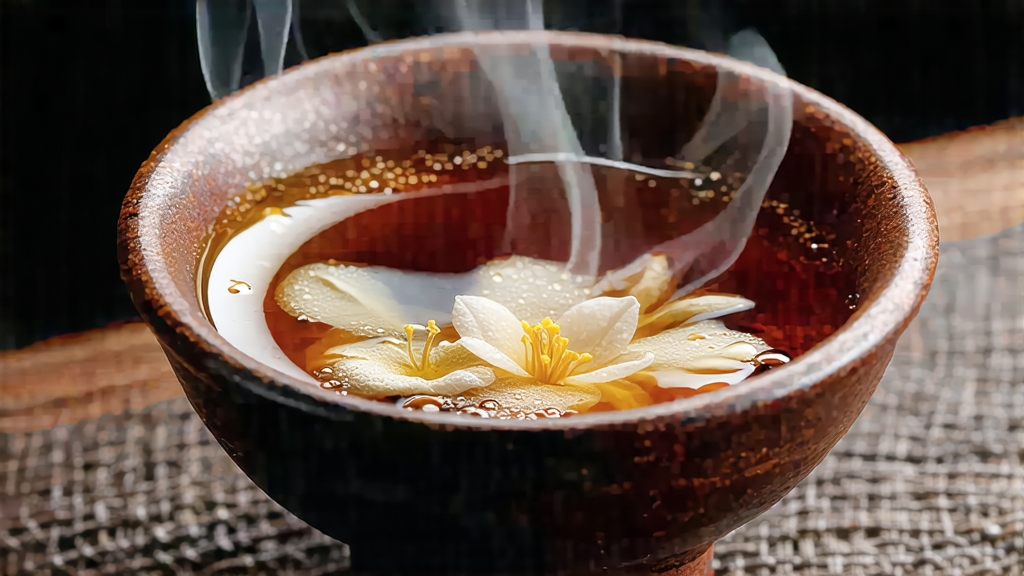
Tucked away in the humid mountains of northern Hunan province, a tea has been quietly fermenting for more than three centuries, its value increasing with every season it spends breathing through the pores of hand-woven bamboo baskets. International drinkers may nod knowingly at Pu-erh, yet few have encountered its lesser-known cousin, the Fu brick—an obsidian slab shot through with a constellation of tiny golden spores that Chinese merchants once called “the flowers of tea.” Those luminous flecks are Eurotium cristatum, a harmless mold that turns crude sun-dried leaf into one of the most complex, mellow and medicinal infusions in the world. To understand Fu brick is to witness the moment when agriculture becomes alchemy, when leaf, water, pressure and time conspire under the watchful eye of artisans who still speak the dialect of the Ming dynasty.
Historical roots
The story begins in the 1640s, when the imperial court moved the Sichuan–Hunan tea tax route northward to feed the horse markets on the Mongolian frontier. Compressed bricks were easier to strap onto pack animals than loose leaf, but the humid march through the Yangtze gorges encouraged spontaneous fermentation. Caravans noticed that bricks arriving in Xi’an after the summer rains had lost their grassy edge and gained a deep, malty sweetness. By the Qianlong era (1736–1795) the Qing government had licensed the Jingyang county workshop as the official “Fu” (literally “government auxiliary”) brick plant, and a style was born. Muslim traders ferried the tea along the Silk Road as far as the Pamirs; Tibetan monks adopted it to counter yak-butter richness; and Kazakh nomads prized it for digestibility after mutton feasts. During the Second World War the Nationalist government even paid soldiers’ wages with Fu bricks when currency collapsed, a testament to their hard-currency status.
Terroir and leaf selection
Authentic Fu brick starts with the late-spring mature leaves of the Anhua small-leaf cultivar, grown between 300–800 m on red-yellow lateritic soil laced with quartz. The bushes sit in a perpetual cloud belt: 78 % average humidity, 180 frost-free days, and temperature swings that coax slow polyphenol synthesis. Growers wait until the leaves broaden to the width of two thumbs—older than green-tea pluck but younger than Pu-erh shaiqing material—then harvest the top four leaves and the banjhi (the semi-hardened fifth leaf). This lignified tissue provides the cellulose that Eurotium will later colonize, converting starches into soluble sugars and releasing the tea’s signature dried-jujube aroma.
Primary processing
The same afternoon the leaf arrives at the village cooperative it is wilted on bamboo racks for three hours, during which moisture drops from 75 % to 62 %. A 3-minute 280 °C drum roast follows—long enough to denature polyphenol oxidase yet short enough to preserve leaf integrity. Unlike green tea, the leaf is then immediately piled 70 cm deep in a cedar-lined room and sprayed with a fine mist of Anhua mountain water. The pile is covered with hemp cloth and allowed to “wet-heat” for 8 hours; temperature is monitored by inserting a forearm: when the center feels like a fevered brow, workers turn the pile. This step, called “qian-dui,” pre-conditions the leaf for microbial invasion and removes the residual grassy note.
Rolling and sun-drying
While still warm, the leaf is rolled for 45 minutes under a 50 kg stone cylinder. The crush–curl–release rhythm ruptures 30 % of cell walls without macerating the surface, ensuring that later fungal hyphae can penetrate but oxygen ingress remains modest. The twisted strips are then spread on bamboo mats and sun-dried for four consecutive afternoons, bringing moisture to 10 %. The semi-dry maocha is now stable enough to be trucked to the historic riverside town of Jingyang, where the real magic begins.
The Fu brick press
Jingyang’s late-summer air carries spores of Eurotium cristatum so thick that laboratory swabs count 3,000 colonies per cubic meter. Artisans blend 80 % maocha with 10 % 2-year-old “huacha” (return tea) for complexity and 10 % steamed rice straw for pliability. The mixture is steamed for 90 seconds at 102 °C, just long